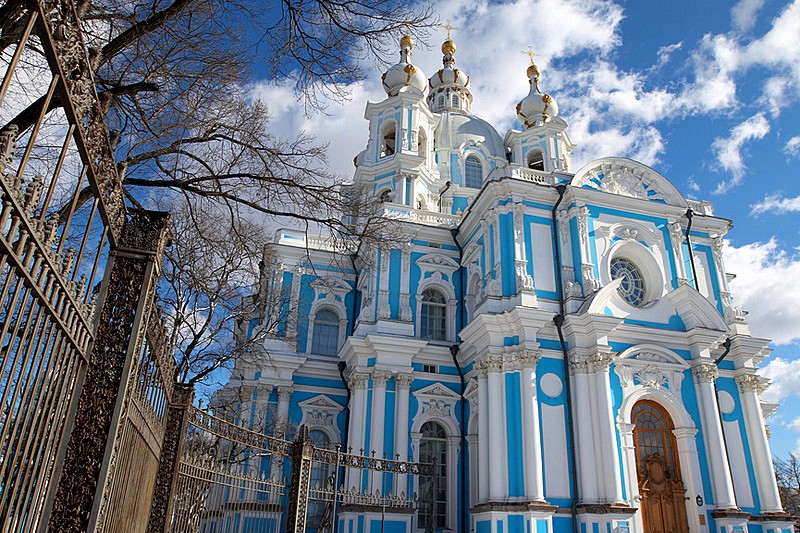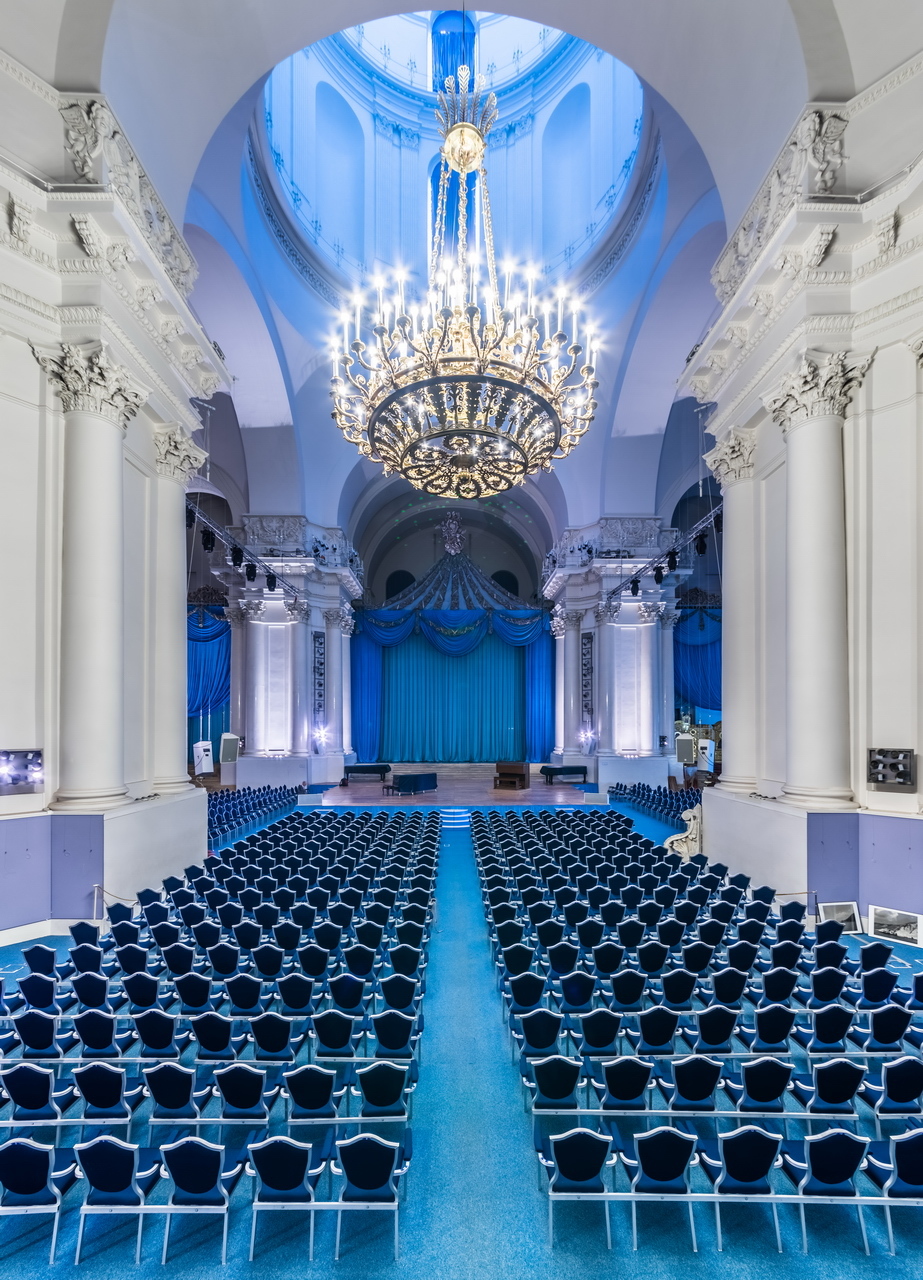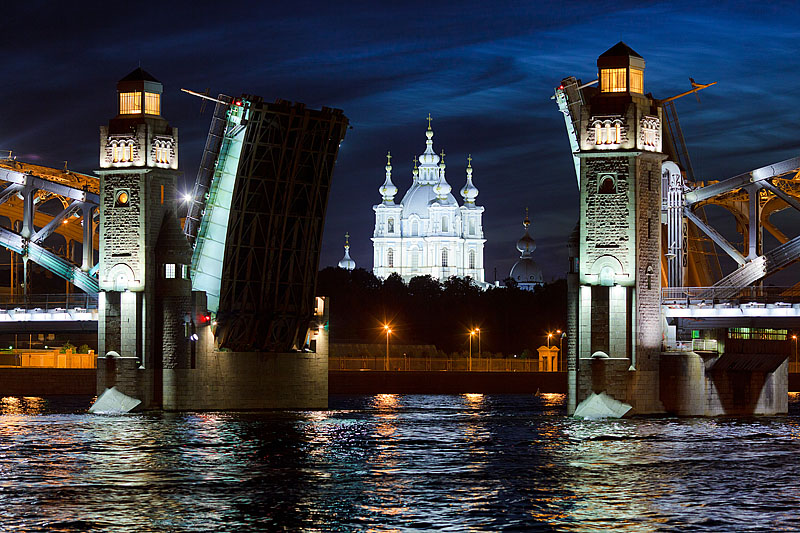Smolny Cathedral
The dazzling cupolas of Smolny Cathedral, one of the most beautiful churches in St. Petersburg, rise majestically from its waterside location on the banks of the Neva River.
Smolny Cathedral was designed by Italian architect Bartolomeo Rastrelli, who came to Russia as a boy with his father, who was invited to the country by Peter the Great and who constructed the Winter Palace and the palace at Tsarskoe Selo. Smolny Cathedral was one of Rastrelli Jr.'s last projects, and one that the great architect left unfinished.
The cathedral was part of a complex planned by the Empress Elizabeth to include a nunnery and a new school for girls - the first and most famous girls' state school in the Russian Empire. Construction began on October 30, 1748, and by 1761 construction of the cathedral was complete. However, in December of that year, Elizabeth died, and work on the monastery came to a halt. Rastrelli was relieved of his duties at Smolny by Catherine the Great, and left Russia in October 1763.
By the early 1830s, much of the cathedral had fallen into disrepair and was becoming overgrown. In 1832, Nicholas I commissioned Vasily Stasov to finish the building. Construction was officially completed in 1835, and the cathedral was on July 22 of that year.
Originally, Rastrelli wanted to a put a bell-tower - designed to be taller than the Peter and Paul Cathedral, at that point the tallest building in the city - next to the cathedral, but his plans were never realized.
A half-circle cast-iron tracery fence with meticulous posts and gates fenced in the entrance to the cathedral. The steps in front of the altar were decorated with a cut-crystal balustrade, while the walls and the columns of the cathedral were finished with white marble and covered with sculpted images. The regal throne was located on the right side of the cathedral under a canopy, while on the other side there was a pulpit carved of white Urals marble and decorated with various carvings. The cathedral's Ark of the Covenant was made of 180 pounds of silver. There were numerous icons and paintings including Alexander Venetsianov's famous Resurrection of Christ.
After the revolution, the cathedral suffered a similar fate to most of the churches in St. Petersburg. In 1922, all of its valuables were looted, and in 1923 the cathedral was closed. For many years, the building was not even heated, had no electricity or water, and it slowly decayed.
Smolny Convent or Smolny Convent of the Resurrection (Voskresensky, Russian: Воскресенский новодевичий Смольный монастырь), located on Ploschad Rastrelli (Rastrelli Square), on the left bank of the River Neva in Saint Petersburg, Russia, consists of a cathedral (sobor) and a complex of buildings surrounding it, originally planned as a convent.
This Russian Orthodox convent was built to house Elizabeth, the daughter of Peter the Great. After she was disallowed succession to the throne, she opted to become a nun. However, her Imperial predecessor, Ivan VI, was overthrown during a coup d'état (carried out by the royal guards in 1741). Elizabeth decided against entering monastic life and accepted the offer of the Russian throne. Work on the convent continued with her royal patronage. [2]
The convent's main church (catholicon or sobor), a blue-and-white building, is considered to be one of the architectural masterpieces of the Italian architect Francesco Bartolomeo Rastrelli, who also redesigned the Winter Palace, and created the Grand Catherine Palace (Yekaterininsky) in Tsarskoye Selo (Pushkin), the Grand Palace in Peterhof and many other major St. Petersburg landmarks. [3]
The Cathedral is the centerpiece of the convent, built by Rastrelli between 1748 and 1764. The projected bell-tower was to become the tallest building in St. Petersburg and, at the time, all of Russia. Elizabeth's death in 1762 prevented Rastrelli from completing this grand design.
When Catherine II assumed the throne, it was found that the new Empress strongly disapproved of the baroque style, and funding that had supported the construction of the convent rapidly ran out. Rastrelli was unable to build the huge bell-tower he had planned and unable to finish the interior of the cathedral. The building was only finished in 1835 by Vasily Stasov with the addition of a neo-classical interior to suit the changed architectural tastes at the time. The cathedral was consecrated on 22 July 1835; its main altar was dedicated to the Resurrection and the two side altars were dedicated to St. Mary Magdalene and Righteous Elizabeth.
The church was closed by the Soviet authorities in 1923. It was looted and allowed to decay until 1982, when it became a concert hall.[3]
The faculties of sociology, political science and international relations of the Saint Petersburg State University are located in some of the buildings surrounding the cathedral.
In April 2015 Smolny Cathedral was returned to the Russian Orthodox Church, and will be converted back to its original purpose as a church.[4]
The nearby Smolny Institute is named after the convent.


